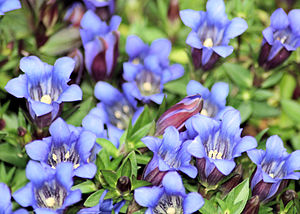Japanese autumn gentian
| Japanese autumn gentian | ||||||||||||
|---|---|---|---|---|---|---|---|---|---|---|---|---|

Gentiana scabra var. Buergeri |
||||||||||||
| Systematics | ||||||||||||
|
||||||||||||
| Scientific name | ||||||||||||
| Gentiana scabra | ||||||||||||
| Bunge |
The Japanese Gentian or Sharp gentian ( Gentiana scabra ) is a plant of the genus gentians ( Gentiana ) within the family of Gentianaceae (Gentianaceae).
description
Vegetative characteristics
The Japanese autumn gentian is a perennial , herbaceous plant that reaches heights of 30 to 60 centimeters.
The opposite arranged stem leaves are sitting. The middle and upper stem leaves have a rough and curved edge and are three to five-nerved. Their simple leaf blade is, with a length of 2 to 7 centimeters and a width of rarely 0.4 to usually 2 to 3 centimeters, linear-lanceolate, ovoid or ovate with a rounded to almost heart-shaped blade base and a pointed to pointed upper end. The lowest leaves are scale-like with a length of only 4 to 6 millimeters.
Generative characteristics
The uppermost leaves are slightly smaller and shorter than the flowers above and surround their base. One to many flowers stand together in terminal or lateral groups and form the entire inflorescence; These lateral groups rarely stand over inflorescence-like lateral branches. The bracts are linear-lanceolate to lanceolate with a length of 2 to 2.5 centimeters. The flowers are sessile.
The hermaphroditic flowers are radial symmetry and five-fold with a double flower envelope . The five green sepals are fused. The calyx tube is 1 to 1.2 inches long and not split. The calyx teeth are spread out to upright and linear with a length of 8 to 10 millimeters with a pointed upper end and rough edges. The five petals are fused. The corolla is blue-purple sometimes with yellow-green spots in the crown throat. The crown is tubular-bell-shaped to funnel-shaped with a diameter of 4 to 5 centimeters. The corolla lobes are ovate to ovate-circular with a length of 7 to 9 millimeters with a rounded and pointed upper end. Between the corolla lobes there are plicae, which are 3 to 4 millimeters long, oblique and narrow-triangular with a pointed upper end or somewhat double-columned. There is only one circle with five stamens , which are inserted in the middle of the corolla tube. The stamens are 0.9 to 1.2 inches long. The free anthers are narrow-ellipsoidal with a length of 3.5 to 4.5 millimeters. The gynophore is up to 1.5 centimeters long. The stylus is 3 to 4 millimeters long.
The capsule fruit is 2 to 2.5 inches long. The seeds are 1.8 to 2.5 millimeters in size.
The flowering period extends from July to November, or in China begins in May; the fruits ripen during the same period.
The number of chromosomes is 2n = 14 or 26.
distribution
The Japanese autumn gentian occurs in eastern Siberia, in the Amur-Ussuri region, in Japan , in Korea and in the Chinese provinces of Fujian , Jiangsu and Zhejiang .
Systematics
The first description of Gentiana scabra was made in 1835 by Alexander Bunge in Memoires de l'Académie Impériale des Sciences de Saint Pétersbourg , Septième Série, 2, page 543. synonyms for Gentiana scabra Bunge are Gentiana fortunei Hook. , Gentiana scabra subsp. australis M.Y.Liou .
Of Gentiana scabra There are two varieties:
- Gentiana scabra var. Buergeri (Miq.) Maxim. : It only occurs in Japan.
- Gentiana scabra Bunge var. Scabra
use
The Japanese gentian is rarely used as an ornamental plant.
In times of famine, when there was nothing else to eat, the young plants and older leaves were eaten cooked.
The medical effects were examined. It is called Long Dan Cao in Chinese traditional medicine and is particularly valued as a bitter medicine.
supporting documents
- Eckehart J. Jäger, Friedrich Ebel, Peter Hanelt, Gerd K. Müller (eds.): Rothmaler - excursion flora from Germany. Volume 5: Herbaceous ornamental and useful plants . Spectrum Academic Publishing House, Berlin Heidelberg 2008, ISBN 978-3-8274-0918-8 .
- Ting-nung Ho, James S. Pringle: Gentianaceae. : Gentiana scabra , p. 53 - online with the same text as the printed work , In: Wu Zheng-yi, Peter H. Raven (Ed.): Flora of China , Volume 16 - Gentianaceae through Boraginaceae , Science Press and Missouri Botanical Garden Press, Beijing and St. Louis, 1995, ISBN 0-915279-33-9 .
Individual evidence
- ↑ a b c d e f g h i Ting-nung Ho, James S. Pringle: Gentianaceae. : Gentiana scabra , p. 53 - online with the same text as the printed work , In: Wu Zheng-yi, Peter H. Raven (Ed.): Flora of China , Volume 16 - Gentianaceae through Boraginaceae , Science Press and Missouri Botanical Garden Press, Beijing and St. Louis, 1995, ISBN 0-915279-33-9 .
- ^ Gentiana scabra at Tropicos.org. In: IPCN Chromosome Reports . Missouri Botanical Garden, St. Louis
- ^ Gentiana scabra at Tropicos.org. Missouri Botanical Garden, St. Louis, Retrieved August 18, 2017.
- ^ A b Gentiana scabra at Plants For A Future . Retrieved August 18, 2017.


